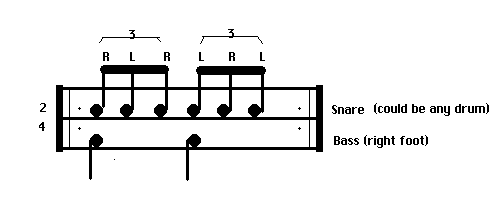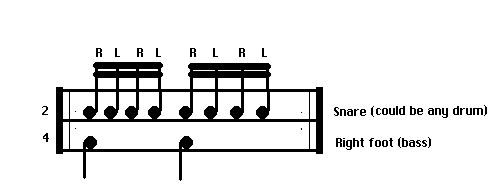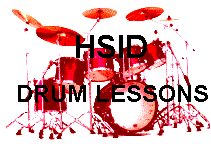Bill Powelson's School of Drums
School of Drums

PRIVATE DRUM LESSON 7E-M:
SOLO TIPS II
8th Triplets & 16th Singles
The March 97 issue of the Tempo Dispatch contained some of my best
tricks and tips for building killer solos.
But, just reading about solos won't do you much good. Follow those
tips to the letter. I promise results! Soloing is an art form and it
must come from within. Input is the first secret! Output is the second.
*** SOLO TIPS II ***
HOW TO GAIN 'INPUT':
Start a collection of solo recordings then begin a routine of
listen/play. Do it on a daily basis! Don't be afraid to inject your
own ideas . . . play what you feel and hear in your head after listening
to some of the worlds greatest drummers. It
is your solo, so you may do anything you choose! There are virtually
no mistakes to worry about! Get it going and don't stop until you
decide it is finished. If something you do sounds good by accident,
do it again. If it sucks, avoid doing it a second time.
***A STARTING PLACE ***
An analytical study of the average solo will show that two roll
types tend to permeate about 80% of the time. What are those roll
types? 16th Singles and 8th triplets.
It might help to study these two rolls, in every form they may
take.
What follows are a few suggestions that should help to get
your own solo engines primed and running:
EIGHTH TRIPLETS:

 Hear them!
Hear them!
Strive to play the above roll pattern blazing fast! Watch TV and
work with the above triplets on a pillow for long periods (like . . .
several eventual hours). Watch the foot! The hard part is playing
the bass along with that fourth note. Don't give up until you can do
it at warp speed with no mistakes. The most common thing that students
will do wrong here is slip into 16th singles as they try to increase
speed with 8th triplets. Avoid doing that by accident! It is a good
maneuver, if you intend to do it but be alert that it isn't happening
by accident.
16TH SINGLES:
This is 16th Singles. Know the difference between 16th Singles
and 8th triplets. Eventually, they will both dominate your bag of
solo tricks . . .

 Hear them!
Hear them!

 Hear triplets & singles mixed together.
Hear triplets & singles mixed together.
Practice switching between 8th triplets and 16th Singles while
maintaining a steady bass flow (or tempo).
*** SOLO SUGGESTIONS ***
Once you can keep a steady bass tempo and switch from one roll to
the other, it will be time to climb behind the kit and begin to do your
own thing. The sky is the limit! There are no mistakes! If you accidently
get your arms and legs tied in a square knot . . . no problem! :>) It
isn't a mistake until you lose or stop the beat flow. Really!! It is
easy to overcome this entangled dilemma! As your hands become
confused . . . stop them but maintain the bass tempo . . . gather
your thoughts for a few beats, then jump back in with a vengeance . . . continue on with another roll pattern.
What follows are *ONLY* suggestions. You may do these ideas in
any order! Also, I should say . . . these are routines that may be
manipulated with *ANY* roll type, including 8th triplets, 16th Singles,
16th Doubles, 16th Paradiddles, 16th triplets, Rogers Ruffs and on and on:
- 1. INJECTING ACCENTS: Play a steady stream of the chosen roll.
Play as softly as you can. Occasionally inject random accented notes
into the stream, using your best hand. Just drop these accents anywhere
it feels natural, they do not need to be close together. The more you do
this the better your control will become.
After awhile, go to work on your lame hand . . . do the same type of routines but do them with your weakest hand. It's good practice! Keep
it simple at first then grow slowly into more complex patterns. It takes
time!
- 2. POWER RIMSHOTS: A 'Power Rimshot' is a rimshot that is done by connecting the rim and head simultaneously, producing a 'ping' sound
(usually done on the snare).
You are playing your roll in a stream of notes and popping accents
as you go. Now add a few super accented 'Power Rimshots'. Play with the
tonal changes that can occur between accents and 'Power Rimshots'. The
rhythmic possibilities are immense. Try to avoid repeating the same
routines. Always seek to create new sounds and rhythms. Drop 'Power
Rimshots' with either hand. Let it flow and try to be creative!
- 3. CROSS-OVER VARIATIONS: With the chosen roll flying on any drum,
reach to any other drum with your best hand, smack it once then return.
Try to maintain the flow of the roll but reach out, occasionally picking
up random notes on any of the toms. Again, get your best hand working
first then focus on the other. Eventually, both hands will be flying
all around the kit. Play with the tones and experiment constantly.
- 4. BROKEN ROLLS: A broken roll is when some of the notes are
omitted in the stream. In other words, we are talking about adding
occasional random rests within the chosen roll. This will probably
happen by accident in the beginning anyway. You will think they are
mistakes. A million fascinating rhythms may be fashioned by simply
stopping at irregular intervals, sometimes by accident and sometimes intentionally. Let them happen, listen for neat ideas as they occur
and try to repeat them on demand.
Try to get the drums talking to each other as in a real conversation.
This will include long and short pauses within the roll stream. Add
dynamics as in a real conversation. There will be times when it sounds
good to scream and times when you want to speak in a whisper. This injects feeling into the solo and it is fun.
- 5. RANDOM CRASHES & CYMBAL TRICKS: Crash the cymbals when you feel
like it! Use crashes as you might use punctuation in a sentence. Try to
add these crashes within the flowing stream of the roll, sometimes. At
other times You may decide to move to the cymbals entirely . . . maintaining your chosen roll but searching for tonal extremes within the different
cymbals. You will be amazed at the variety of tones that may be produced
from a cymbal. Every cymbal will have its own personality and range of
tonal values. Strive to find them all and use them advantageously in your solos.
- 6. JINGLES & RHYMES: This gets back to accents and 'Power Rimshots'
but we will add a twist. As you gain control with accents, try to play a melodic jingle or sing-song accent pattern over the top of your roll stream. Think the melody of 'Jingle Bells' (Christmas Carol) and bring it out as
accents within a roll stream. Next, try, 'Three Blind Mice', 'Mary Had A
Little Lamb' or anything else you can come up with. The listening audience
may never realize the tune you are thinking. That isn't the point! Your
solos will become more melodic as you do this. It adds continuity and
substance to an otherwise boring ration of racket.

 VIDEO: Click here to 'Play', see, and hear a short solo using the tips in this lesson.
VIDEO: Click here to 'Play', see, and hear a short solo using the tips in this lesson.
If you are the extremely studious type, you might look for books that focus on
topics like triplet accents and cross-overs. There are even a few books
out there that focus on single, double and paradiddle roll development.
I could fill reams of paper with practice routines in each category.
You would see endless lines of a particular roll with added accents and complicated cross-over examples. You would see them . . . but would you
study them? Most of us bore with that stuff real quick. I know I do!
I hold to the original formula . . . 'listen then play'. In that
order! You will get where you want to be much quicker this way.
Good luck! Burn 'em!

Copyright Bill Powelson 1994 all rights reserved.



